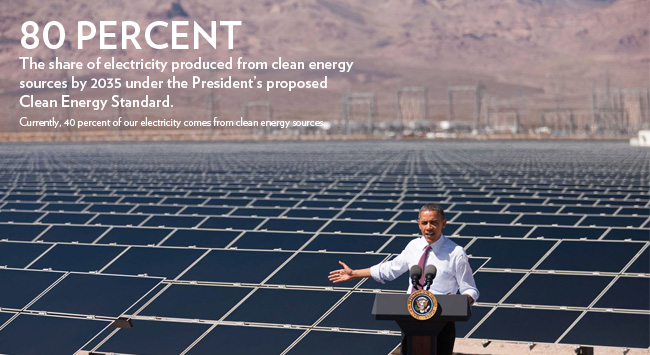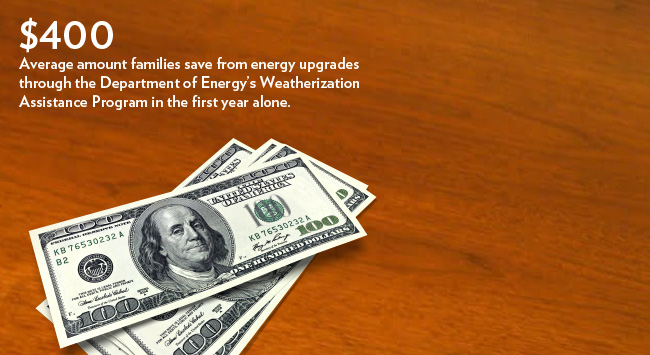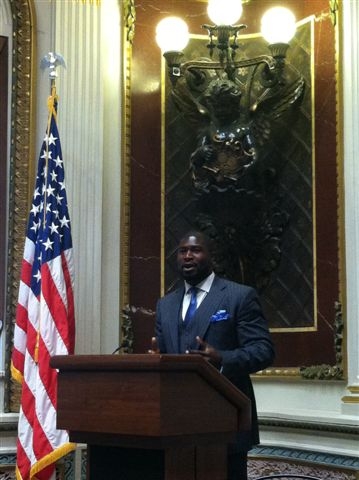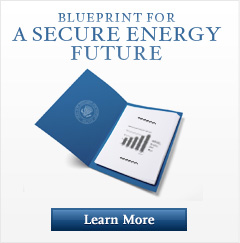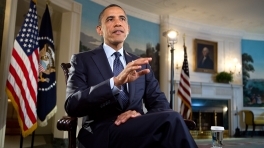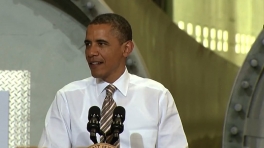Energy and Environment Latest News
Promoting Sustainability Through Sports
Posted by on July 19, 2012 at 11:46 AM ESTI am honored to speak today as part of a White House Event on Sports and Sustainability. As a professional athlete and an advocate for clean, healthy communities, it is a privilege to speak on behalf of athletes and sports arenas across the country who are working to promote a sustainable future.
In 2008, I established the Ovie Mughelli Foundation to help educate children about how their environment affects them. Through the foundation, I have had the opportunity to work with leaders across sectors who share the goal of educating millions of Americans about promoting sustainability in today's world. We also share the Obama Administration’s commitment to encouraging measures that save energy, reduce pollution, and foster healthy and successful living environments.
A major part of my efforts has been to leverage the opportunities I’ve gained as a professional football player to encourage not only adults but also young people to take action at home. With the promotion of practical lifestyle changes within our everyday communities, we have encouraged people to champion actions that keep their communities healthy, including through fun activities that combine sports with environmental education. Most importantly, the Mughelli team strives to foster leadership in the next generation to build a green movement that addresses their needs and concerns.
It’s an honor to participate in this White House event – I plan to continue to work with others in the sports community and outside of it to raise awareness about the steps we can all take to provide for a healthy and sustainable future.
Ovie Mughelli is a National Football League Pro Bowl fullback and founder of the Ovie Mughelli Foundation, a nonprofit organization that educates children about the environment
Learn more about Energy and EnvironmentResponsibly Expanding America’s Offshore Energy Development
Posted by on July 18, 2012 at 9:54 AM ESTIn recent weeks, the Department of the Interior announced a key component of President Obama’s all-of-the-above energy strategy: a five-year program for offshore oil and gas leasing that will allow our nation to expand safe and responsible oil and gas development to help power our economy. The five year program, which we developed after extensive input from the public, states, tribes, and others, makes more than 75% of recoverable energy resources in our oceans available for exploration and development – including frontier areas in the Alaskan Arctic. At the same time, we are also taking steps to identify additional resources in currently undeveloped areas to inform future development decisions.
The five year program we are implementing builds on the President’s strong record on oil and gas development. Nationwide, domestic oil and natural gas production has increased every year President Obama has been in office. In 2011, American oil production reached the highest level in nearly a decade and natural gas production reached an all-time high. America’s dependence on foreign oil has gone down every single year since President Obama took office. We have cut net imports by ten percent – a million barrels a day – in the last year alone. At the same time, we have implemented comprehensive reforms in the wake of the Deepwater Horizon oil spill in the Gulf of Mexico that has made offshore development safer and more responsible.
Under the administration’s five year program, we have delivered what the American people have asked for: a smart way forward that focuses on the areas that contain the overwhelming majority of the resources rather than simply opening areas for the sake of achieving an imaginary acreage threshold.
Learn more about Deepwater BP Oil Spill, Energy and EnvironmentOpen Data for a Clean, Secure Energy Future
Posted by on July 12, 2012 at 10:42 AM ESTFreely-available data from the Federal government and other sources can be a powerful input to private sector innovation. Open data can spur entrepreneurship, empower citizens, and create jobs. As just one example, data from the US Global Positioning System (GPS) have been utilized by entrepreneurs to power navigation systems, precision crop farming tools, and other innovations that add over $90 billion in value to our economy each year and have improved the lives of Americans in many ways.
The Obama Administration recently launched a series of Open Data Initiatives—in health, public safety, education, and energy. The Energy Data Initiative (EDI) aims to help Americans benefit from entrepreneurial innovation enabled by open energy data from the US government and other sources. By working to make energy data more available and useful to entrepreneurs, we’re confident that new products and services will continue to emerge to help American families and businesses save energy and money, protect the environment, and ensure a reliable energy future.
Learn more about Energy and Environment, Technology“No” Can Be a Good Thing
Posted by on July 6, 2012 at 1:08 PM EST
Terri Turner, chosen from a from a pool of more than 1,500 candidates nominated through the White House web site, was selected as a Champion of Change for the positive impact she is making in her community.
I came from a family with a strong work ethic. My Daddy used to tell me that if I wasn’t giving 100%, that I was cheating someone - I learned very quickly that, most of all, I was cheating myself if I wasn’t giving my all, and then some, to those around me. So I was always doing “more,” giving “more,” trying to be “more.” It was quite natural that I ended up in a community service field. For the past 18 years, I have worked for City and County governments as a Planner, Floodplain Manager and Hazard Mitigation Specialist (among a lot of other hats that I just quite naturally wear with my present position as Augusta, Georgia’s Development Administrator).
Learn more about Energy and Environment, ServiceReducing Asthma Disparities
Posted by on July 5, 2012 at 3:39 PM ESTAs a primary care pediatrician and leader of the Community Asthma Prevention Program of the Children’s Hospital of Philadelphia, I am very excited about the Coordinated Federal Action Plan the Obama Administration recently announced to reduce asthma disparities. For years there have been a number of disparate efforts from various federal agencies to address asthma disparities; yet the gap in asthma-related emergency room visits, hospitalizations and deaths still exist. Asthma is a disease that is impacted by a host of environmental, health and social factors. Therefore it’s no surprise that efforts made in a singular fashion have not worked in the past. This Coordinated Federal Action Plan represents the coming together of 16 federal agencies to use their collective strengths to collaboratively and systematically reduce, and someday eliminate, asthma disparities.
This plan recognizes the importance of the community’s involvement in efforts to reach disparate populations and the importance of collaboration among healthcare providers, community agencies, and social support systems. The following two strategies resonate with my experience in taking care of children with asthma:
- The standardization of training and certification of Community Health Workers (CHW) and utilization of CHW’s in care of at-risk asthmatics
The Community Health Worker is often the unsung hero in the frontline effort to intervene in the disproportionate burden of asthma on disadvantaged communities. These highly trained lay health educators are effective in working together with families to increase self-management skills and to remove asthma triggers as well as provide care coordination services. CHW’s are often the glue that connects caregivers to the healthcare system, community resources and social support systems and a key driver in community efforts to reduce asthma disparities. Given their important role in working with the most vulnerable populations suffering from the burden asthma places on their lives, standardization of curriculum and certification of CHW’s is a necessary step in providing wrap around asthma care to reduce asthma disparities and asthma costs.
- Promoting collaboration across all systems that serve children with asthma including health care, housing, schools and childcare settings
While disseminating best practices in implementing asthma guidelines is a step in improving overall asthma health outcomes, it is essential that the asthma care plan accompanies the child where they live, learn and play. Strategies toward this goal include: creating communication channels via federal interagency and private partnerships to provide comprehensive services to the people most affected by asthma; sharing data (including asthma care plans) between health care and school/childcare systems; and equipping federally qualified health centers and hospitals who serve disadvantaged populations to implement best practices.
The Coordinated Federal Action Plan provides guidance for approaching asthma disparities in a holistic fashion recognizing that patients live in the “real” world where their housing, health and education are all interconnected. Using all resources available and intervening in an integrated, collaborative manner will give us the greatest chance for finally closing the gap on asthma disparities.
Tyra Bryant-Stephens is Director and Founder of the Community Asthma Prevention Program at the Children’s Hospital of Philadelphia, and Clinical Associate Professor of Pediatrics at the University of Pennsylvania School of Medicine
Learn more about Energy and EnvironmentMajor Step Forward for Gulf Coast Restoration
Posted by on June 29, 2012 at 6:17 PM ESTToday Congress took a major step in our efforts to restore the Gulf Coast and support the important communities that rely on it everyday. Earlier today, Congress enacted the Resources and Ecosystems Sustainability, Tourist Opportunities and Revived Economies of the Gulf Coast States Act (RESTORE Act).
This Administration recognizes that a strong and vibrant ecosystem is the key to the Gulf’s future - that's why the President established the Gulf Coast Ecosystem Restoration Task Force in 2010. As Chair of the Gulf Coast Ecosystem Restoration Task Force and a New Orleans native, I can tell you that a healthy ecosystem is vital to the economy and the way of life for the Gulf Coast. There’s a lot at stake in this region: the economies of the five Gulf States supported more than 19 million jobs and nearly $2.5 trillion of the U.S. GDP in 2008. In addition, millions of people visit the Gulf Coast each year – to vacation, to sail, to swim, to fish, and to enjoy this great waterbody. In 2008, national and international tourists spent about $145 billion in the 5 coastal states and around 1.7 million people were employed in travel and tourism.
During the oil spill, we essentially “lost” the Gulf for a period of time, and natural resources in the Gulf were extensively damaged. We lost the use of valuable fishing grounds, incredible recreational opportunities and all of the other benefits of a thriving, vibrant ecosystem. That loss helped show folks who aren't from the Gulf Coast just how important it is to our nation.
But our goal and commitment is not simply to address the damage caused by the spill - it is to ensure the long term improvement and restoration of the Gulf Coast and its unique ecosystems.
- &lsaquo previous
- …
- 2
- 3
- 4
- 5
- 6
- 7
- 8
- 9
- 10
- …
- next &rsaquo
White House Blogs
- The White House Blog
- Middle Class Task Force
- Council of Economic Advisers
- Council on Environmental Quality
- Council on Women and Girls
- Office of Intergovernmental Affairs
- Office of Management and Budget
- Office of Public Engagement
- Office of Science & Tech Policy
- Office of Urban Affairs
- Open Government
- Faith and Neighborhood Partnerships
- Social Innovation and Civic Participation
- US Trade Representative
- Office National Drug Control Policy










